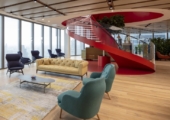March 6, 2013
Economic benefits of green buildings highlighted

Green buildings can be delivered at a price comparable to conventional buildings, with investments recouped through operational cost savings and, with the right design features, create a more productive workplace, says the World Green Building Council (WorldGBC). A new report, which looked at the benefits from green buildings received by different stakeholders throughout the life cycle of a building, “synthesizes credible evidence from around the world on green buildings into one collective resource, and the evidence presented highlights that sustainable buildings provide tangible benefits and make clear business sense,” said Jane Henley, CEO of WorldGBC. More →




























February 28, 2013
Workplace Anachronisms: No. 1 – the BCO Specification Guide
by Mark Eltringham • Comment, Facilities management, Property, Workplace design
More →